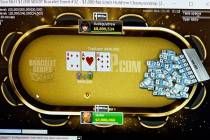MGM’s new problem gambling program designed to raise awareness
There’s no such thing as luck, but compulsive gamblers should at least feel fortunate that the state’s largest employer is introducing a problem gambling program that locals will begin seeing soon.
While it isn’t perfect, the GameSense program MGM Resorts International will unveil by the end of the year has the potential of providing a technological tap on the shoulder to players who can’t quit gambling when they should.
MGM was ordered by Massachusetts gaming regulators to implement the program in that state when MGM Springfield opens its doors next year. When company officials took a look at GameSense, they decided to introduce it to all its U.S. properties, including 10 in Las Vegas.
MGM is partnering with the British Columbia Lottery Corp. to introduce the high-profile awareness program.
It’s expected that GameSense will have a visible presence in MGM casinos with signage, kiosks and a team of advisers who will be trained to look for and talk to distressed gamblers who probably should have quit playing earlier.
One of the missions of GameSense will be to educate people about how gambling works so that they make better decisions about their play limits. Bo Bernhard, the executive director of UNLV’s International Gaming Institute, says GameSense will function like a product label, giving consumers detailed information about the entertainment they’ve chosen to participate in.
It’s going to mean blowing up some of the commonly held misperceptions about slot machines, such as “this machine is due to hit” or that a certain machine is “cold” or “hot.” The reality is that a player has the same random odds for a favorable outcome every time the game is played.
MGM also is giving UNLV $1 million over five years to gather research on problem gambling, and that research and some policy and regulatory questions MGM will have to review could lead to even greater player awareness.
Imagine if a player could set limits for time or money spent playing and place those parameters onto the player’s loyalty card. When a player reaches that limit of time or money, the machine produces a reminder to the player. At that point, the player must make a decision: Should I reject the self-imposed limitation, or should I stick to the commitment I made?
Clearly, a player can simply remove the loyalty card and quit playing or go someplace else to gamble.
Alan Feldman, executive vice president of global government and industry affairs for MGM and a longtime advocate for problem gambling awareness programs, said some research has suggested that getting an earlier reminder about nearing the limit for time or money spent has produced a negative result. Instead of winding down, the player increases bets or tries to chase a loss more aggressively.
That’s why the UNLV research, which will be shared with the University of British Columbia and Harvard University’s medical school on addictive behavior, is so important. The right balance must be struck to be effective, and researchers will try to find out what that is.
GameSense doesn’t have all the answers.
But it’s a good start.
Contact Richard N. Velotta at rvelotta@reviewjournal.com or 702-477-3893. Follow @RickVelotta on Twitter.






















